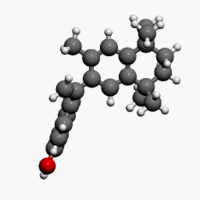 | |
 | |
| Clinical data | |
|---|---|
| Trade names | Targretin |
| AHFS/Drugs.com | Monograph |
| MedlinePlus | a608006 |
| License data |
|
| Routes of administration | By mouth, topical |
| ATC code | |
| Legal status | |
| Legal status | |
| Pharmacokinetic data | |
| Protein binding | >99% |
| Metabolism | Hepatic (CYP3A4-mediated) |
| Elimination half-life | 7 hours |
| Excretion | Parent drug and metabolites are eliminated primarily through the hepatobiliary system. Less than 1% is excreted in the urine unchanged. |
| Identifiers | |
| |
| CAS Number | |
| PubChem CID | |
| IUPHAR/BPS | |
| DrugBank | |
| ChemSpider | |
| UNII | |
| KEGG | |
| ChEBI | |
| ChEMBL | |
| CompTox Dashboard (EPA) | |
| ECHA InfoCard | 100.206.790 |
| Chemical and physical data | |
| Formula | C24H28O2 |
| Molar mass | 348.486 g·mol−1 |
| 3D model (JSmol) | |
| |
| |
| (verify) | |
Bexarotene, sold under the brand Targretin, is an antineoplastic (anti-cancer) agent used for the treatment of cutaneous T cell lymphoma (CTCL).[4] It is a third-generation retinoid.[5]
It was approved by the U.S. Food and Drug Administration (FDA) in December 1999, and the European Medicines Agency (EMA) in March 2001. It is available as a generic medication.[6][7]
- ^ "FDA-sourced list of all drugs with black box warnings (Use Download Full Results and View Query links.)". nctr-crs.fda.gov. FDA. Retrieved 22 October 2023.
- ^ Anvisa (31 March 2023). "RDC Nº 784 - Listas de Substâncias Entorpecentes, Psicotrópicas, Precursoras e Outras sob Controle Especial" [Collegiate Board Resolution No. 784 - Lists of Narcotic, Psychotropic, Precursor, and Other Substances under Special Control] (in Brazilian Portuguese). Diário Oficial da União (published 4 April 2023). Archived from the original on 3 August 2023. Retrieved 15 August 2023.
- ^ Cite error: The named reference
Targretin FDA labelwas invoked but never defined (see the help page). - ^ Gniadecki R, Assaf C, Bagot M, Dummer R, Duvic M, Knobler R, et al. (September 2007). "The optimal use of bexarotene in cutaneous T-cell lymphoma". The British Journal of Dermatology. 157 (3): 433–440. doi:10.1111/j.1365-2133.2007.07975.x. PMID 17553039. S2CID 33092727.
- ^ Yuan S, Chan JF, Chik KK, Chan CC, Tsang JO, Liang R, et al. (September 2020). "Discovery of the FDA-approved drugs bexarotene, cetilistat, diiodohydroxyquinoline, and abiraterone as potential COVID-19 treatments with a robust two-tier screening system". Pharmacological Research. 159: 104960. doi:10.1016/j.phrs.2020.104960. PMC 7254006. PMID 32473310.
- ^ "2022 First Generic Drug Approvals". U.S. Food and Drug Administration (FDA). 3 March 2023. Archived from the original on 30 June 2023. Retrieved 30 June 2023.
- ^ "Competitive Generic Therapy Approvals". U.S. Food and Drug Administration (FDA). 3 March 2023. Retrieved 6 March 2023.